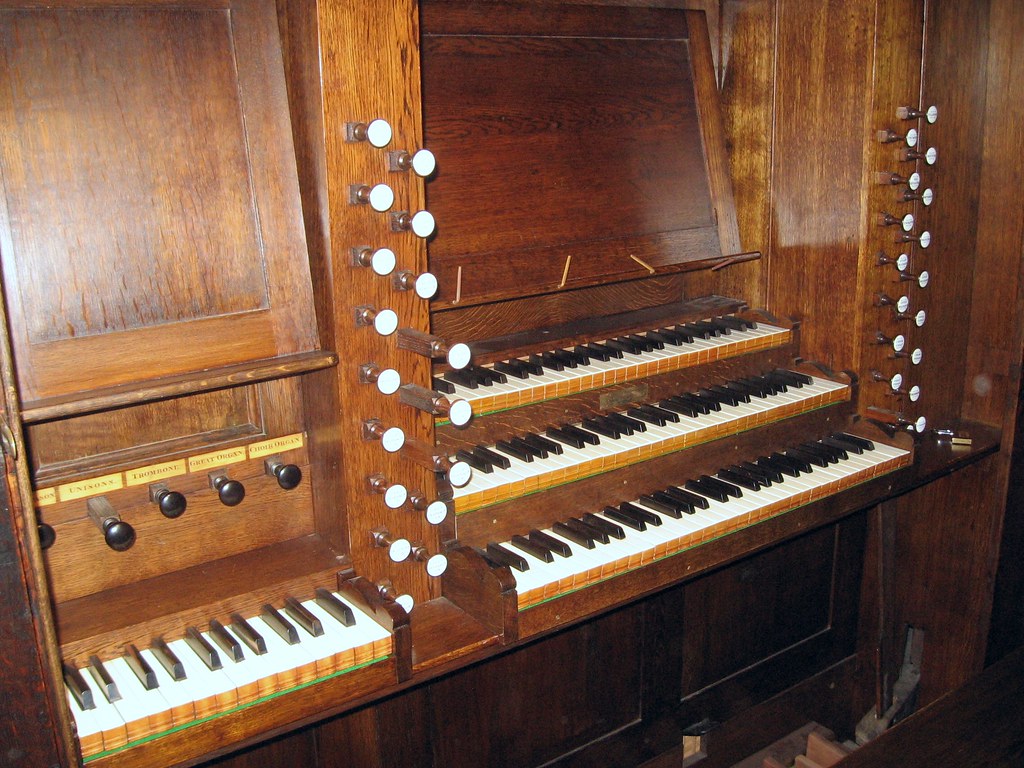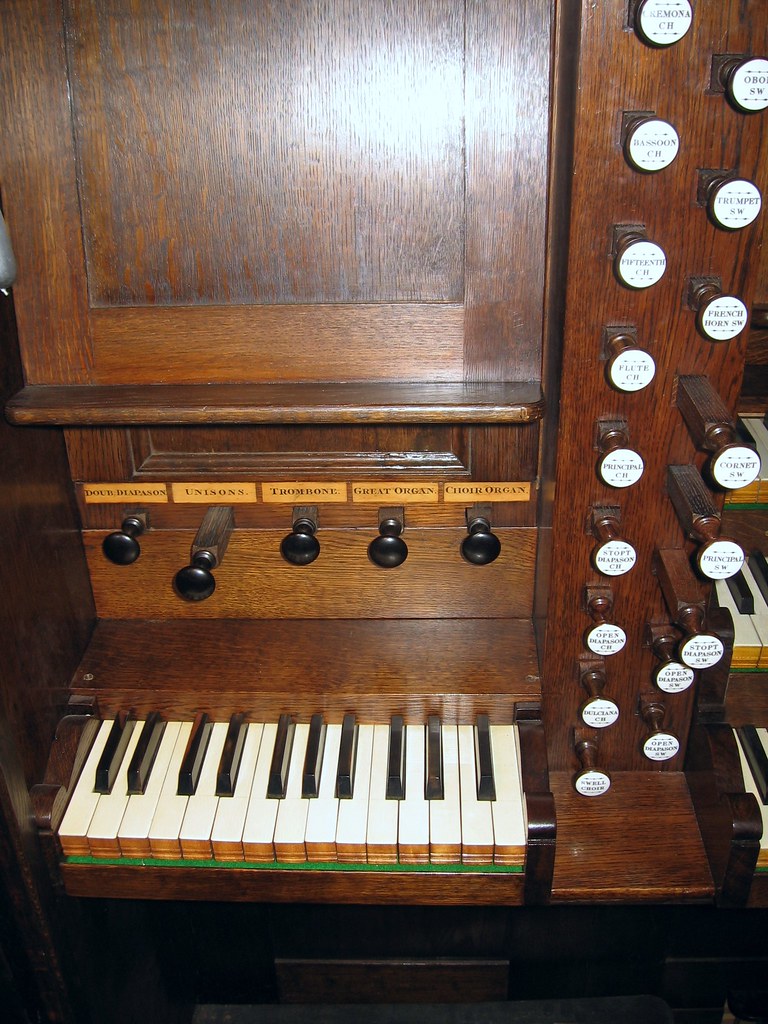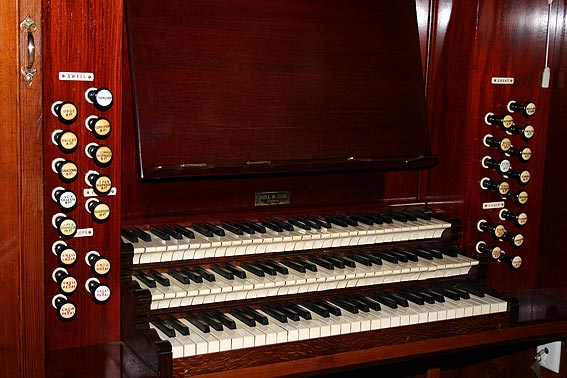
James Goldrick
-
Posts
109 -
Joined
-
Last visited
Posts posted by James Goldrick
-
-
must be an Americanism to give the pieces names
Peter
I believe it was referred to as the 'Cathedral' Prelude & Fugue in Cesar Franck's recital programmes. I think it was the only piece he ever played, apart from his own works and improvisations.
Would that one could have a concert organist career like that these days...
-
First of all, may I commend to all of you this recording of GTB cruising effortlessly through the Bach Toccata in F BWV 540 at a superhuman pace.
Certainly one of the most electrifying records ever made.
However, the details list this as being recorded on the BBC Compton Organ at Maida Vale in 1933 (as does the EMI re-issue CD). Three years before the organ was built, according to NPOR.
Is the recording from a later date, or was it recorded on another instrument? (Logic suggests the BBC Theatre in Langham Place [Compton - 1933])
JG
-
Phenomenal recordings.
Thank-you very much.
-
In what way?
Does this mean you would prefer an instrument tuned to (for example) Werckmeister III? I wonder how that would work with a lot of the romantic repertoire?
I heard an evensong from Magdalen College, Oxford, a few years ago. Personally I thought that the accompanimnet to the Howells setting they sang sounded dire - purley because of the 'unequal' temperament tuning. I realise that Howells is not the only thing sung there (or at King's). However, King's do perform the odd bit of Howells, Stanford, Bairstow, etc. To my ears, this never seems to sit well on an instrument with anything other than 'equal' temperament tuning.
I've always thought unequal temperament doesn't necessarily do Howells a disservice. I came to this conclusion after hearing one of the Psalm-Preludes in recital on the Mander at Sydney Grammar School (Vallotti), where those crunching dissonances gain an extra bite - particularly the clashing false relations.
Similarly, I can't help but prefer the New College, Oxford recording of the New College Service for Priory to say, the newer Hyperion recording from Wells (Archer). The organ's temperament makes the Gloria's G-major modulation particularly luminous, as well as that wonderful chord immediately preceding 'and to the Son', which doesn't make such an impact in ET.
That said, I'm sure the opening of the Gloucester Service would sound hideous in Werckmeister III
-
My experience of Hohl Flutes has been almost exclusively bad. ARE there any nice ones anywhere?
The Great Hohl Flute at Christ Church Cathedral, Newcastle in Australia has to be one of the finest of its type.
The pipework is Norman & Beard 1906, incorporated into the superb rebuild in 1963 by J.W. Walker. [stoplist]
played by Michael Dudman (fixed broken link) -
Eleventh Church of Christ Scientist, Marylebone
This looks to be quite an appealing specification with something of a sticky future ahead.
"2008 - organ to be removed Jan. 2009 and scrapped unless another home
can be found; (DPi);"
-
Can anyone point me in the direction of tonally intact J.W. Walker organs with Clarion Mixtures?
-
That would be St James, Bermondsey, which has just been restored to its 1829 condition by Goetz & Gwynn - long compass and all!
It was one of the earliest instruments in England to have pedals, and I suppose there was some doubt as to whether any English organists would be able to play them, hence the little keyboard which a second player could use to play the pedal part.
Oh yes - I have a photograph of this somewhere. It looks weird - but then the ethos behind it was also slightly weird. Rather like the once commonly-held belief that if man were to travel in excees of a certain (somewhat moderate) speed, death would ensue rapidly.


-
I think that there must have been one on the organ at Riverside Church NYC, because Virgil Fox once used it to 'cheat' whilst playing - very quickly - the pedal solos in the Toccata, in F, by JSB. Apparently, GTB played it just as quickly with his feet - and got all the notes correct! (No doubt our friend will answer that comment!)
The proof of the pudding...
-
Here's a stunning Youtube video (audio-only) of Yves Devernay at Notre-Dame improvising a sortie for Easter Sunday Mass, straight after the conclusion of Handel's Hallelujah Chorus.
It seems out of the four titulaires, Devernay was the true successor of Cochereau.
-
Draw one Tuba more !
Pierre
If only...
Unfortunately the St Andrew's Cathedral Letourneau is equipped only with two quite unpleasant 16,8 Bombardes. It is planned to re-instate the 1930 Whiteley Solo Division (With Tuba) from the organ's previous incarnation.
-
Here's a recently added video of Sydney City Organist Robert Ampt demonstrating the Sydney Town Hall to our good host.
Demonstrates:
Solo Tubas
Full Swell
Full Great
Full Organ
Mutations (Great Twelfth and Echo Glockenspiel)
Great, Swell and Pedal Mixtures
64' Contra Trombone
32' Contra Posaune
Love the cathedral roll in the empty hall!
-
That's interesting, because I didn't know that H,N & B made diaphones.
Were they just for theatre-organs, or were they fitted elsewhere?
MM
There was a heroic example of a 32' H,N&B Diaphone from 1929 at Melbourne Town Hall. (Constructed at the firm's Melbourne factory, in fact.) However, in the unforgivable rebuild by Schantz in 2001 (where all but the pipework and case were discarded), the zinc pipes of the Diaphone were lost in a factory fire in the USA and were replaced by Schantz. Despite the efforts to prevent the vandalism of this whole project (led by the Christopher Dearnley and the Organ Historical Trust of Australia), it still causes one to smart at the destruction of the integrity of such a fine example of the British inter-war civic organ.
Given the exorbitant price of the rebuild, one wonders how much of a stretch it would have been to commission an entirely new 'American Classic' of similar size, whilst respecting the integrity of an undeniably superb, if not entirely fashionable work of art.
All that said, I can't help but be amused to wonder if perhaps the Schantz replacement was the first 32' Diaphone rank to be constructed from scratch in about 50 years. (If I am mistaken, please correct me; I feel there may be a glaringly obvious exception)
-
Stop jamb bushes is the answer you're looking for. This is the ivory collar that is glued into the stop jambs and is lined with felt to prevent the drawstop shanks rattling around.
What a handsome console !
H
As you say, just the answer I was looking for.
Thank-you very much.
I was beginning to despair when the answers were about the stop-domes. Upon re-reading, the wording of my question could have been better!
-
As it says in the Topic Title, this is a minor query, but today I was practising on a relatively untouched 1890 Hill & Son organ in Newcastle, Australia (See below). The white circular insert surrounding the Gt. Open Diapason knob kept popping out with the stop itself.
As I was writing a note in the tuner's book, I could not think of the right term to use.
Is there an official term for these 'white circular inserts'?
St Andrew's Presbyterian Church, Newcastle

-
I have just listened to the first and fourth movements again. I note that the toccata ends with the inevitable French march....
Now compare this to just one example of a similar type by Cochereau. For example, the Sortie (Messe de 11h30) 1er décembre 1968. Taken from the second disc of the three-disc set Pierre Cochereau l'organiste de Notre-Dame. FY Solstice: SOCD14-96.
The harmonic language is considerably richer, there is more excitement - with a well graded climax - and another march.... It is also somewaht more technically complex.
Yes, I noticed the French march was a trait Cochereau inherited from his teacher. There's the splendid conclusion to the Sortie on 'Adeste Fideles', the amusing Finale to the Variations on 'O Filii et Filiae' from the 3-CD set. (I can't pick the tune, but there's a hint of Battle Hymn of the Republic!) and above all the Prelude, Chorale & Variations on 'Marche des Rois' (from Improvise sur des Noels); IMHO the greatest Cochereau improvisation I've yet heard.
I agree with every observation you make, and I'll just say that I believe Cochereau surpassed his maitre in all improvisational genres except Fugue. However, I do think that in the D-minor Finale, Dupre's toccata figuration is far more coherent than the typical Cochereau toccata. This is why I think the less frenzied of Cochereau's toccatas are more succesful, eg. the Adeste Fideles sortie.
-
Apparently, Tournemire almost invariably ended the sortie after Mass quietly. He would also stand on the pedals at moments of great tension or exaltation during an improvisation.
Weird.
I've seen Virgil Fox do the same thing for the final note of BWV 532!
-
I too put Cochereau above Dupre.
Tournemire too.
My favourite Dupre improv is the Symphonie in D-minor from Cologne Cathedral (1957).
The fantastic fourth movement toccata has the closest I've heard of Dupre displaying 'reckless abandon' thanks in part to the splendidly simple theme.
Incidentally, does anyone know the publisher of 'Zephyrs' a Dupre improv reconstructed by Rollin Smith from an organ-roll?
-
I've never really enjoyed Guillou as an improviser.
Guillou's (loud) improvs all seem to build up to a frenzied climax, and then he just ceases playing without any sense of finality or anti-climax. It's probably some deliberate anti-establishment statement, so typical of Guillou; I just find it disappointing.
Also, Roth always seems to have harmonic and timbral colour as top priority, whilst Guillou is all about making statements.
To me, it's the difference between a poet and an orator.
Incidentally, my top 5 improvisers are:
(chronologically)
1. Tournemire
2. Dupré
3. Langlais
4. Cochereau
5. Roth
Not too dissimilar really...
-
The playing, as always with M. Roth is exemplary - although I am less happy with his improvisations. I do possess a copy of his improvisation CD which was also mentioned on the same thread; however, next to recordings by Cochereau, Pincemaille or even Grünenwald, for me, it is just not in the same league.
Dear pcnd,
If you are in doubt about Roth's position amongst Cochereau and Pincemaille etc., I must recommend you these two videos:
(4m16s is a real goosebumps moment)
Also, try to get your hands on the CD 'La Tradition de Saint-Sulpice' for a stunning improv on Kyrie 'Orbis Factor'.
I'm dying to get the Widor Mass CD where Roth improvises in various 19th Century styles, and the new Vierne Messe Solennelle CD where he and Eric Lebrun improvise in dialogue a la Widor and Faure.
-
Hereford Cathedral
Sydney Town Hall
----------------------
Not in the same league, but I was absolutely smitten with this instrument when I played it last year:
St. Brigid's Catholic Church, Red Hill (Queensland)
(A near perfect example of how a small specification is transformed by a sympathetic acoustic... and the Trumpet is to die for)
-
I thought I might open this subject for discussion, since I don't believe it has been a thread on this board, as of yet.
In your opinion, what is the greatest piece of organ music written by a British composer? This extends from the Robertsbridge Codex to the contrapuntal masterwork that might have been composed last week in a pub in Staffordshire.
My choice goes to Elgar's Sonata in G Op.28, which I predict will be a contender in the majority of people's opinions. That said, the often surprising diversity of opinion is one of the most notable charac teristics of the Mander Board community.
My second choice goes to Thalben-Ball's incomparable Elegy in B-flat and third place to Howells' Psalm-Prelude Set 2, No.1 'De Profundis".
The only difficulty in my choice was whether to consider the Willan Introduction, Passacaglia & Fugue. Willan had only been living in Canada for three years when this work was published, so there is a slight grey area whether this is a Canadian work or a British one.
I look forward to further contributions.
James Goldrick
-
Here's the funniest man on Earth giving useful tips on liturgical improvisation:
Bill Bailey - The Church Organist
P.S. Bill Bailey for Eurovision '08!!
-
Many years ago, and having discussed it with the officiating priest, I played the Entree from Messe de la Pentecote during ther Offertoty on Pentecost Sunday. I provided the priest with an explanatory note saying that the descent of the tongues of fire was illustrated by a descending pedal motif
I apologise that I'm not expanding on your question, but this motif has always had me slightly flummoxed. I once thought it might be a phrase of Gregorian chant, because Naji Hakim uses the same motif as the basis of the third movement of his Hommage a Igor Stravinsky triptych.
Is this a reference to his predecessor at Trinite or is there a common root to both compositions?
Bach Chaconne
in The Organ
Posted
Does anyone know if the Henri Messerer transcription used by Olivier Latry on his 'Midnight from Notre-Dame' disc is available anywhere?